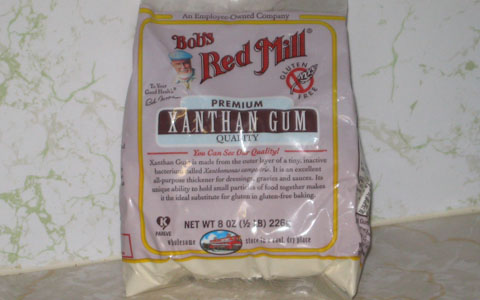|
|
 |
Changes to basic cheesecake batter composition, mid-2017
My
experiencing a very delicious cheesecake from Trader Joe's back
around early June of 2017 prompted me to give further consideration to
overhauling the basics of my cheesecake recipes. The efforts began with
Prototype 17 of my plain cheesecakes
and ended with
Prototype 21.
Earlier in these updates I did a little tweaking with the crust. But the far
more important changes throughout the updates would involve the batter.
I felt that I should cut back on the tartness of the cheesecake's batter,
so I replaced half of the yogurt cheese with additional cottage cheese. In
other words, the cheese base's cottage-Neufchatel-yogurt ratio went from
1:1:4 to 3:1:2. It seemed like this helped enhance the taste somewhat, but
I still wasn't satisfied.
But the most significant change affected the stabilizer.
My cheesecake history began with what has probably been the most popular
stabilizer in baking—wheat-type flour. I used different kinds of
this flour, such as all-purpose and whole white.
As the years went by, I started bringing arrowroot on board (this
stabilizer getting its debut very likely in mid-2012), earlier to
supplement the wheat-based flour and later to replace it. It was probably
around mid-2015 when I outright retired the wheat-based flour, so the
arrowroot was on its own at that point. It seemed to have considerably
more stabilization strength compared to its wheat-oriented predecessor.
Recently, I tried a rather risky experiment. I made a cheesecake with no
stabilizer added. That was
Prototype 18.
This wasn't the first time that I had done this. I also made
Prototype 8
this way, and that one was exceptionally delicious. But it was also
exceptionally soft. But Prototype 8 contained only yogurt cheese for the
cheese base. Prototype 18, on the other hand, also contained cottage
cheese and Neufchatel cheese, and these two products already had some
stabilizers in them, particularly xanthan gum—an industrial
staple.
Fortunately, Prototype 18 was not an unstable disaster (a little sloppy,
yes, but not so runny). And its taste was really terrific, pretty much
like Prototype 8's and Trader Joe's. This outcome put arrowroot in the
crosshairs.
But what would be a superior alternative to arrowroot? I was looking for
sufficient stability, but I was also in the hunt for a really great taste,
just like I would enjoy with a more typical, fat-laden cheesecake.
The time had come to give xanthan gum—an ingredient available for retail
sale, at least in recent years from Bob's Red Mill—a try.
This stabilizer has been put to
extensive use in the food industry—and particularly in cream cheese
(often in conjunction with guar and/or locust/carob bean gum here)! But I
didn't think that xanthan gum had been embraced anywhere nearly as much in
homes. Maybe one of the reasons was the difficulty in using it. I myself
have incurred a number of failures in the past with this ingredient—often
by using too much of what I found out the hard way to be an overwhelmingly
powerful stabilizer!

But how much, then, should I use? I Googled around and was led to start
off small—very small—with this potent ingredient. So I
carefully put xanthan gum to work in
Prototype 19,
and the results worked
out reasonably well. The batter tasted awesome, but I wanted to tweak the
stability. This adjustment, which included the amount of baking time, as
well as how much xanthan gum to use, would ultimately lead up to Prototype
21, with which I would close out this basic overhaul of 2017.
So the resulting basic cheesecake batter would now involve these
ingredients:
Cheese base (such as cottage/Neufchatel/yogurt)
Xanthan gum (supplementing whatever stabilizers were already included in
the cheese base ingredients)
Eggs
Granulated sugar
Vanilla
Compare and contrast the conventional list:
Cream cheese (with a sufficient amount of its own stabilizers,
particularly xanthan gum)
Eggs
Granulated sugar
Vanilla
Now that's very close!
In early October, not long after my overhaul efforts with my plain
prototypes, I furthermore decided to try an "egg-speriment"
(or, "eggs-experiment") with
Prototype 7 of my maple cheesecakes.
I added one
egg on top of what I primarily had been using for nearly the past two
years, i.e., I went from five eggs to six. While "one egg for every
eight ounces of cheese base" seemed to be mathematically convenient,
using a half-dozen eggs per cheesecake had a couple of advantages. One
would make my grocery shopping easier, because of the way eggs have been
packaged—typically in multiples of six (I scarcely have been using
this ingredient for any other purpose). The other would be beneficial for
the cheesecake's firmness and texture. The outcome of the maple cheesecake
itself was great, so I decided at this point to utilize the sixth egg on
a regular basis. |
|
|

|

